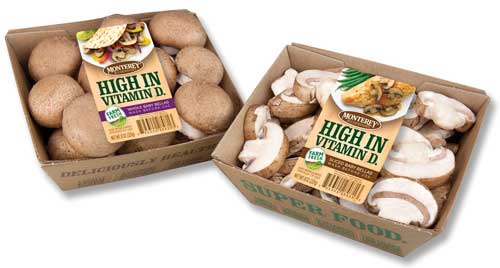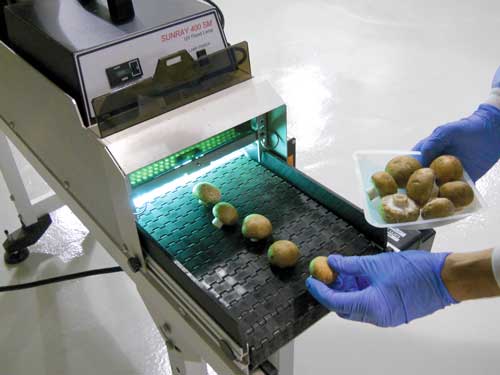UV Processing of Mushrooms Enhances Vitamin D Content
PROCESSING
 If you look up processed foods on the Internet, you will find a long list of articles linking processed foods to poor health. Yet in reality, it is a myth that food processing is inherently unhealthy. Under many circumstances, processing actually enhances the healthfulness of foods.
If you look up processed foods on the Internet, you will find a long list of articles linking processed foods to poor health. Yet in reality, it is a myth that food processing is inherently unhealthy. Under many circumstances, processing actually enhances the healthfulness of foods.
This month’s food processing column focuses on the recent commercial application of ultraviolet (UV) light processing to improve the healthfulness of mushrooms by enhancing their vitamin D content. Although UV processing of foods is known for its food safety benefits, it can also be used to improve the nutritional content of mushrooms and other specialty crops.
The Importance of Vitamin D
More than 40% of American adults are deficient in vitamin D. Vitamin D is required for calcium balance and bone mineralization, and vitamin D deficiency can lead to softening of bone in children and adults as well as osteoporosis in adults. Recent work also suggests vitamin D may protect against chronic inflammatory and infectious diseases, including colon cancer, breast cancer, prostate cancer, cardiovascular disease, Alzheimer’s disease, and autoimmune disease.
Vitamin D is synthesized in humans and other animals following exposure to UV light. Current recommended practices to avoid sun exposure and wear sunscreen compromise vitamin D synthesis in the body. In addition, dark-skinned individuals have more melanin, which acts as a sun block inhibiting UV light penetration, thus reducing vitamin D production.
Natural food sources for vitamin D are limited to a few animal sources, such as some fish and fish liver oils and a few foods, such as milk, cereal, and some fruit juices, which are fortified with vitamin D. In order for Americans to meet the recommended dietary allowance of vitamin D, additional food sources are required.
The current recommended dietary allowance for vitamin D is 600 IU per day. This is triple the value that was previously considered adequate for adults until the recommended dietary allowance was increased in 1997. The U.S. Dept. of Agriculture’s (USDA) National Nutrient Database—the foundation of most food and nutrition databases in the United States—includes the vitamin D values for many foods. In it, mushrooms stand out as the only source of vitamin D in the produce aisle and one of the few nonfortified food sources. This is thanks to a new UV treatment process that has been commercially implemented in recent years.
Principles of Ultraviolet Processing
There are three regions of UV light within the electromagnetic spectrum. These are UV-A (315–400 nm), UV-B (280–315 nm), and UV-C (200–280 nm). In the past, food processing applications have focused on the use of UV-C light. UV light exhibits germicidal properties in the UV-C spectrum. Destruction of microorganisms occurs due to penetration of UV-C light into the outer membranes of cells, leading to DNA damage and eventual cell death. The use of UV-C light is well established for water treatment, air disinfection, and surface decontamination. In 2000 the USDA approved UV light as an alternative treatment for pasteurization of fresh juice products. Newer applications include pasteurization of juices, post lethality treatments for meats, and extended shelf-life for fresh produce.
There are many lamps that artificially produce UV. A variety of UV source types are available, including continuous UV low-pressure and medium-pressure mercury lamps, pulsed-UV, and excimer lamp technologies. Low pressure lamps emit most of their radiant energy in the UV-C spectrum. These lamps can be hot cathode, cold cathode, slimline high output, and light-emitting diodes. Commonly available UV-B lamps include broad band and narrow band lamps. Narrow band lamps produce radiation of 311–313 nm wavelength, with a peak wavelength of 312 nm. Broad band lamps produce radiation over the full UV-B spectrum of 280–315 nm wavelengths, with a peak wavelength of 306 nm.
UV light penetrates food materials only a few millimeters depending on the optical properties of the food. Water is transparent to UV light wavelengths and easily penetrated, whereas turbid beverages and foods are only surface treated. One of the main advantages of using UV for disinfection is that it alleviates the need for heat to kill microorganisms.
--- PAGE BREAK ---
 Ultraviolet Processing of Mushrooms
Ultraviolet Processing of Mushrooms
Mushrooms exposed to UV light (UV-B or UV-C) produce vitamin D2. Mushrooms contain a compound called ergosterol that converts into vitamin D2 when exposed to UV light. This reaction occurs in all mushrooms, including white, brown, and portabella mushrooms. It occurs at slow rates when mushrooms are exposed to the sun, and the reaction time can be shortened drastically by exposing the mushrooms to high doses of high intensity UV light.
Several research teams, including one at the USDA Agricultural Research Service in Albany, Calif., and another at Pennsylvania State University, have studied effects of UV light on vitamin D production in mushrooms. These studies began in the laboratory using systems like the Uvitron Sunray (see photo below).
Prior to these recent studies, reports could be found in the literature stating that UV exposure resulted in vitamin D production in mushrooms. However, prior research on UV treatment of mushrooms employed excessively long process times, in the range of hours, to produce desirable levels of vitamin D in mushrooms. It was only recently, in the past five years, that higher intensity UV treatments were explored in order to increase the dose of UV exposure and enable commercially viable processing of vitamin D–enhanced mushrooms. These recent studies were able to reduce the process time needed to produce high levels of vitamin D in mushrooms from hours to mere seconds. UV-B, UV-C, and pulsed UV-C have been utilized to produce high levels of vitamin D in mushrooms. Postharvest time does not have a significant effect on vitamin D formation, and there are no significant changes in the sensory properties of the mushrooms as a result of the UV treatments. Furthermore, vitamin D levels are stable after cooking.
These results have been transferred into commercialization. Currently there are several large companies, including Monterey Mushrooms, Watsonville, Calif. (www.montereymushrooms.com), and Dole Food Co., Westlake Village, Calif. (www.dole.com), that manufacture and sell mushrooms that are high in vitamin D. Commercial mushrooms such as these provide 100% of the recommended dietary allowance of vitamin D in a serving of mushrooms and can now be found in stores around the country.
Commercial mushroom powders are also being manufactured and sold by companies like Oakshire Naturals, Kennett Square, Pa. (www.oakshirenaturals.com), and PLT Health Solutions, Morristown, N.J. (www.plthealth.com). These mushroom powders can provide up to 40,000 International Units of vitamin D per gram and can be added to foods as non-GMO, clean-label, natural ingredients that provide significant amounts of vitamin D.
It is also important to note that human clinical trials have demonstrated that the vitamin D present in mushrooms is bioavailable and is equally effective in raising and maintaining a healthy adult’s vitamin D status as ingesting a supplement that contains vitamin D.
Opportunities for UV Processing of Other Crops
In addition to converting ergosterol into vitamin D in mushrooms, UV light treatment can be used to improve the nutritional value of other plant products. Abiotic stresses such as UV light affect many pathways involved in the biosynthesis of the three principal groups of secondary metabolites: phenolics, terpenes, and nitrogen-containing compounds, all of which can provide health benefits to humans. Many scientific studies have shown that the antioxidant content of a wide range of fruits and vegetables, including strawberries, tomatoes, colored potatoes, carrots, blueberries, and others, can be enhanced through treatment with UV light. Greater benefits are generally realized when fruits and vegetables are treated with UV-C light rather than UV-B light.
UV-B light can be used effectively as a postharvest treatment to enhance the antioxidant content of carrots and fresh-cut carrot products. Both cutting style and UV dose level are factors in determining carrot responses to UV-B treatment. Antioxidant capacity can be increased significantly (up to 6.6-fold) through a high intensity, short time treatment. This increase is due to an increase in phenolic content and, more specifically, an increase in the compound called chlorogenic acid.
To date these processes have not been commercialized; however, in the future they may be used to enhance the nutritional value of fruits and vegetables, as well as fruit- and vegetable-based products and ingredients such as antioxidants, natural colorants, dietary supplements, and natural antimicrobials.
 Tara McHugh, PhD, Contributing Editor
Tara McHugh, PhD, Contributing Editor
Research Leader, USDA Agricultural Research
Service, Albany, Calif.
[email protected]


